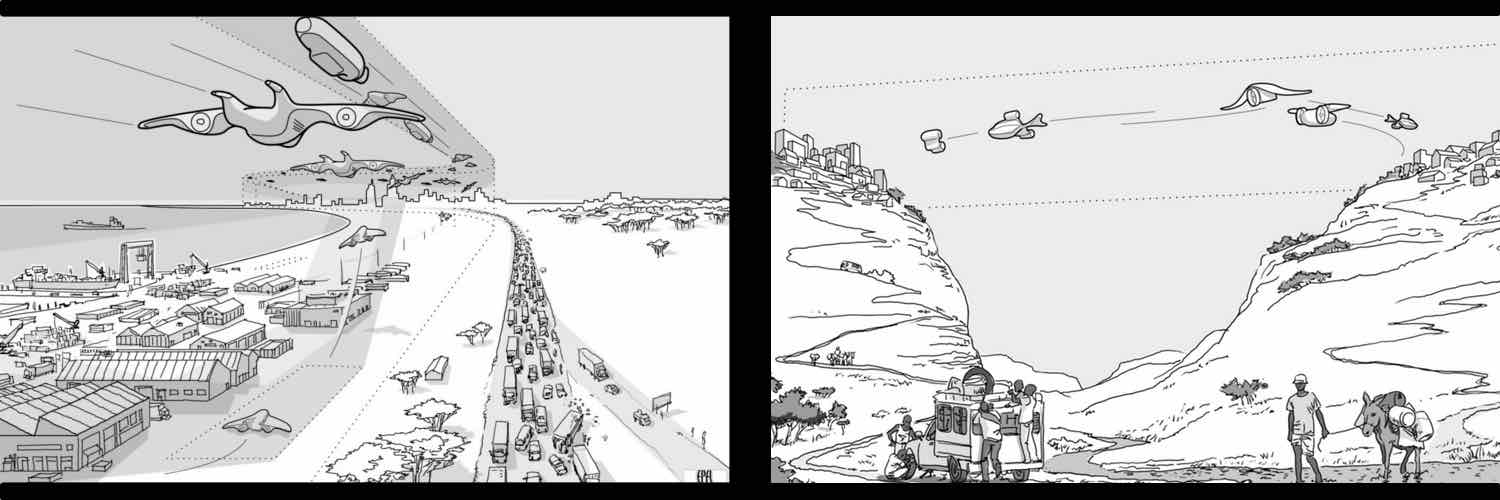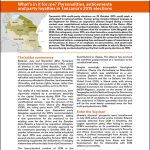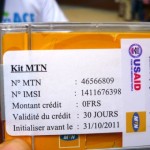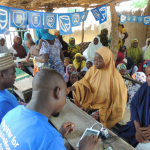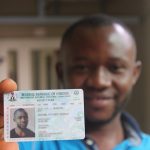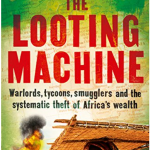- Staying Power: Referenda in the Republic of Congo and Rwanda have paved the way for presidents Sassou Nguesso and Kagame to extend their tenures. In the Democratic Republic of Congo (DRC), President Kabila appears intent on remaining in power beyond the end of his second term in November 2016. Kabila’s political machinations have been met with violent protest and international opprobrium. By contrast in Benin, incumbent president Boni Yayi has resolved to step down when he completes his second term in February 2016.
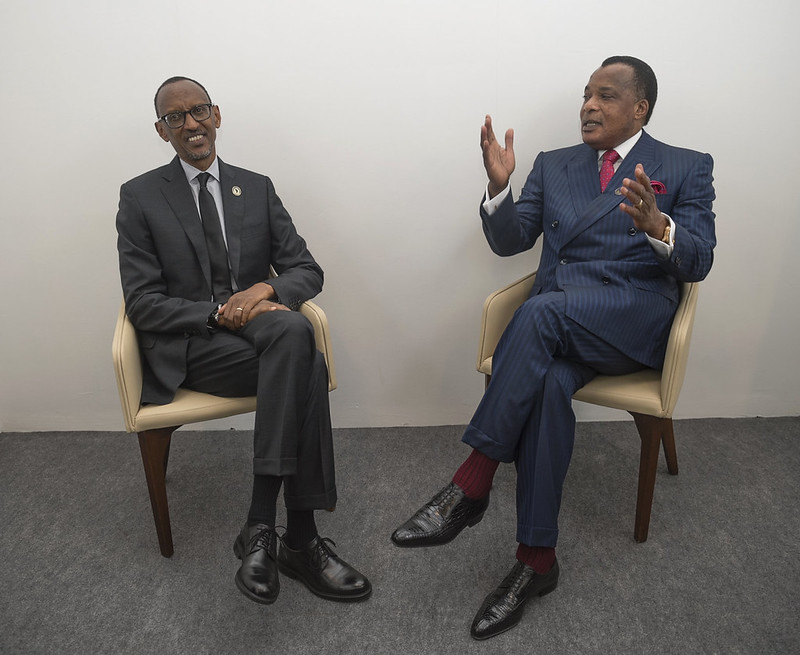 Image: President Kagame meets with President Denis Sassou Nguesso of Congo-Brazza on the sidelines of African Union Summit | Kigali, 17 July 2016 (Flickr,
Image: President Kagame meets with President Denis Sassou Nguesso of Congo-Brazza on the sidelines of African Union Summit | Kigali, 17 July 2016 (Flickr, 
licensed under a Creative Commons Attribution-NonCommercial-NoDerivs 2.0 Generic License).
- Africa Debt Rising: Sovereign bond issuance rose dramatically as commodity markets peaked in 2014, before tailing off as the price of oil and export minerals collapsed. With budget deficits approaching unsustainable levels in many countries and the supply of cheap debt in decline, some African governments face tough choices – cut spending or dramatically improve domestic revenue collection. This new reality will be inescapable for Zambia and Ghana in an election year. In 2015, their currencies were devalued substantially and visits from the IMF further raised concerns about the sustainability of debt levels. 2016 may see the IMF revert to a more familiar role of supervising austerity measures, albeit in a less conspicuous fashion than during the structural adjustment era; whilst Ghana accepted IMF support, Zambia has so far rejected a financial bailout package.
- Economic Opportunity: African economies that rely heavily on oil and other commodity exports – including Nigeria, Angola and Zambia – continue to suffer due to low or declining prices. But this setback also provides an opportunity to focus on diversifying their economies. In Nigeria, there is much talk of revitalising agriculture. In East Africa, efforts are being made to reduce economic inefficiencies and improve productivity: progress in regional telecom reform, for example, demonstrates much from which the rest of the continent can learn.
- Insecurity in Nigeria: Many Nigerians voted for Muhammadu Buhari because of his campaign commitments to tackle corruption and defeat Boko Haram. The arrest of former National Security Adviser Sambo Dasuki for allegedly overseeing illicit and financially fraudulent transactions worth billions of naira is highly symbolic. Despite an announcement that the government has “technically won the war” against the Boko Haram insurgency, military action has not yet been convincing and the threat remains. The renegotiation of the Niger Delta amnesty and recent agitation by Biafran separatists illustrate the security challenges facing Buhari’s government.
- Urban Transport: In September 2015 Addis Ababa opened the first part of a new 17km light rail system funded in part by Chinese investment. A similar venture that forms part of the urban plan in Lagos has been beset by delays. However, Governor Ambode of Lagos State has promised that the first line will be operational by December 2016. Dar es Salaam’s bus rapid transit (BRT) system failed to open as planned in October 2015 but is expected to launch in the first quarter of 2016. New urban transport networks will need to be affordable for the everyday commuter if they are to successfully reduce congestion and improve the productivity of cities.
- Flying Donkeys: The world’s first civilian cargo drone station is set to open in Rwanda in 2016. “Flying donkeys” will be capable of carrying small packages across distances of up to 80km and could help to overcome some infrastructure challenges. Regulation concerning the use of unmanned vehicles is in the process of being drafted by Rwanda’s civil aviation authority and a successful pilot should see a nationwide network of cargo drone routes established.
- Sorting out the Union: The post-election crisis in Zanzibar has highlighted the shortcomings of Tanzania’s current political configuration and reignited calls for power to be shared more equitably among the constituent parts of the Union. Tanzania remains the only African nation to possess a dual-government structure, a lopsided arrangement that falls short of being a fully-fledged federation. Zanzibar retains its own executive, legislature, and judicial system; while a parliament in Dodoma and a president in Dar es Salaam take decisions for both the mainland and the Union as a whole. Tanzania’s president, John Magufuli, may consider constitutional reform as a solution to the impasse in Zanzibar; however, he will face resistance from his own party, which has repeatedly rejected changes to the status quo.
- The Prominence of Social Media: African youth harnessed the potential of modern communication tools to mobilise protests in Burkina Faso and South Africa, successfully preventing a military coup and halting significant rises in university tuition fees. Twitter hashtags are becoming important tools for mobilisation and are likely to become more prominent as the cost of communication decreases. Governments are already responding to this perceived threat. Tanzania rushed through four pieces of legislation relating to access to information, media, statistics and cybercrime in 2015, while Nigeria may adopt a social media bill in 2016.
- The Battle for the ANC: In South Africa, rumours have been circulating about plots to oust President Zuma mid-term. Zuma famously usurped Mbeki as ANC president at the national conference in Polokwane in December 2007, positioning him to become head of state, following the April 2009 elections. Zuma’s decision to fire Nhlanhla Nene as finance minister was an assertion of his authority that backfired. With the ruling party likely to lose control of important metropolitan authorities at municipal elections in 2016, the campaign to succeed Zuma will dominate South African politics right up until the next ANC national conference in December 2017.
- A Changing Climate: In 2015, flooding in Freetown and Accra devastated urban areas whilst El Niño brought drought to rural Zimbabwe and Ethiopia. Unpredictable weather will be a continuing feature in years to come, despite the agreement reached at COP21 in Paris. Long term commitments can work alongside short-term solutions: improved urban management and support for the growing of drought resistant crops like finger millet. But weather can also offer opportunity for the continent. Renewable energy, in particular solar, wind and geothermal, has been cited as a key avenue for tackling the power deficit on the continent by African Development Bank president, Akinwumi Adesina.
Nick Branson and Jamie Hitchen are researchers at ARI.







